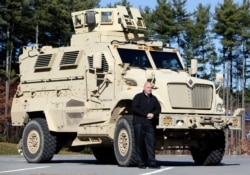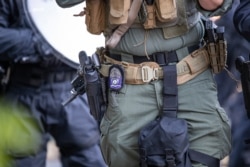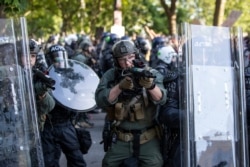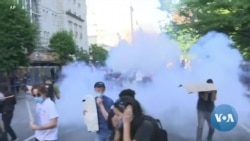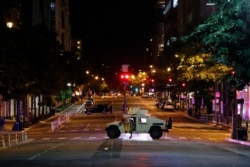A decades-old Pentagon program that donates surplus military-grade weapons and vehicles to local police departments is drawing fresh scrutiny amid the weeks-long protests over the death of African American George Floyd while in the custody of Minneapolis police.
The initiative, known as the "1033 program," has provided police departments with more than $7 billion worth of equipment since 1991, including hundreds of millions of dollars' worth of military-grade equipment, ranging from semi-automatic assault rifles to 40-ton Mine Resistant Ambush Protected vehicles (MRAPs) built for American troops in Afghanistan and Iraq.
Local law enforcement officials defend the program, saying the equipment has saved lives and enabled police to respond to emergencies. But critics say the gear encourages officers to use heavy-handed tactics and weaponry during routine drug searches and street protests such as the ongoing demonstrations over Floyd’s death.
In response to public outcry that the 1033 program helped foster police militarization, former President Barack Obama’s administration in 2015 put severe limits on the program, banning the transfer of bayonets, grenade launchers and other military weapons and equipment. Police departments returned 126 tracked armored vehicles, 138 grenade launchers and 1,623 bayonets.
But President Donald Trump revoked the restrictions in August 2017, with former Attorney General Jeff Sessions dismissing the Obama administration’s concerns about the program as “superficial” and criticizing the limits on “life-saving” equipment.
Since then, the Defense Department program has provided an additional $1 billion of what it calls “excess property” to police departments throughout the country, according to the Defense Logistics Agency (DLA).
Partly relying on donated military equipment, armed police officers decked out in riot gear have been deployed around the country, inviting comparisons to army soldiers. In parts of the country, police have used tear gas, flash bangs, pepper spray and rubber bullets to disperse crowds of protestors.
The display of force suggests many police departments have “not gotten the message” that demonstrators are protesting heavy-handed police tactics, said Tom Nolan, a former Boston police officer and now a sociology professor at Emmanuel College.
“The level of militarization that has been used to meet that increased level of protest is more significant and a more heavy presence than we saw in 2014,” Nolan said, referring to nationwide protests triggered by the fatal shooting of a young black man, Michael Brown, by white police officer Darren Wilson in Ferguson, Missouri.
Those demonstrations prompted debate about tensions between police and the African American community, the militarization of police and the excessive use of force.
Local law enforcement officials say it’s unfair to blame the use of military equipment for excessive force by police.
“The equipment is not the problem,” said Houston Police Chief Art Acevedo, who is also president of the Major Cities Chiefs Association.
In San Marcos, Texas, police used an MRAP to rescue children during the historic floods of 2015, Acevedo said. Last year in Dayton, Ohio, police armed with a military-grade long gun took out a suspected shooter who had killed nine people.
In Houston, the nation’s fourth-largest city, police officers have not used MRAPs or Humvees during the current protests, he said.
Nevertheless, Acevedo said, police militarization remains a “legitimate issue” worth debating.
“What we need to think about is what equipment is being provided” to law enforcement, Acevedo said. “How is it being used? What are the policies and procedures for their use? What is the oversight? What is the command and control?”
Roots in the 1960s
Police militarization dates back to the 1960s when the U.S. government first began giving money to police departments to buy military equipment to fight crime. But it did not take off until Congress in 1989 authorized the transfer of surplus military equipment to local police departments in what eventually became known as the 1033 program.
The impetus for the initiative, according to Nolan, was America’s then-raging war on drugs, when average police officers were outmatched by drug lords with powerful automatic weapons.
In the wake of the terrorist attacks of September 11, 2001, this police militarization expanded further as the federal government poured billions of dollars in funding and equipment into police departments to fight terrorism, turning them from law enforcement agencies into “front-line shock troops in the war on terror,” according to Nolan.
Although the Departments of Homeland Security and Justice provide far more money to local law enforcement, police departments have long viewed the 1033 program as an easy catch with few strings attached. In 2017, the General Accounting Office created a fictitious federal agency and was able to obtain more than 100 controlled items worth an estimated $1.2 million.
“It's basically like a catalog of free equipment,” said Carl Takei, a senior attorney at the American Civil Liberties Union (ACLU) who focuses on police practices.
To date, the Defense Department has transferred nearly $7.5 billion worth of equipment to about 8,200 police departments, according to the DLA. Typically, small arms weapons make up 5 percent and tactical vehicles less than 1 percent of the transferred equipment, according to DLA.
The MRAPs, originally built for U.S. troops in Afghanistan and Iraq, are among the most sought-after items. Thousands became available for transfer to police departments after U.S. forces left Iraq and sharply reduced their presence in Afghanistan. To date, the DLA has transferred 3,915 MRAPs, 9,868 Humvees and 1,441 aircraft, according to a spokeswoman.
Many of the MRAPs and other free military goods have gone to small to mid-sized police departments that critics say have no need for them.
The sheriff’s office of Banks County, Georgia — population 19,000 — has received nearly $2 million worth of equipment under the program, including an MRAP (valued at $733,000) and two utility trucks, according to DLA.
In Idaho, the Caldwell Police Department has received two MRAPs, valued at $1.5 million, in addition to personal protective shields, laser range finders and other items, according to DLA data. Caldwell has a population of 56,000.
Even school districts have gotten their hands on some of the surplus equipment.
In 2014, the Los Angeles Unified School District police received an MRAP, three grenade launchers and dozens of semi-automatic assault rifles. Amid public outcry, the school police returned the grenade launchers but kept the rest, with the police chief saying at the time that the “life-saving” equipment would be used “for extraordinary circumstances.”
Despite such claims that tactical gear is used only in extraordinary situations, a 2014 ACLU analysis of more than 800 SWAT deployments found that the majority was for routine drug searches.
Because the Obama-era restrictions were so quickly rescinded, they had little impact on the flow of military goods into police departments.
According to the DLA, more than $1 billion worth of equipment was transferred to law enforcement agencies from 2017 to 2019. Although the program has stopped transferring armored vehicles and grenade launchers, it has provided 579 bayonets — described by a DLA spokeswoman as “utility knives” — to police departments since 2017.
In the wake of Floyd’s death, congressional Democrats, backed by an assortment of advocacy organizations, are seeking once again to limit free access to the surplus military ware.
A recently introduced Democratic bill known as the Justice in Policing Act would limit the use of military equipment to counter-terrorism operations and require police departments to notify their communities before requesting such equipment from the Defense Department.
Law enforcement groups and their supporters in Congress oppose the move.
“They use bulletproof vests and bulletproof shields to protect our officers who protect our communities,” Republican House member Greg Steube of Florida said Wednesday. “Stripping them of that ability, and stripping them of their ability to use weapons to protect themselves, is a dangerous path to go down. And I don’t think that our country supports that.”





